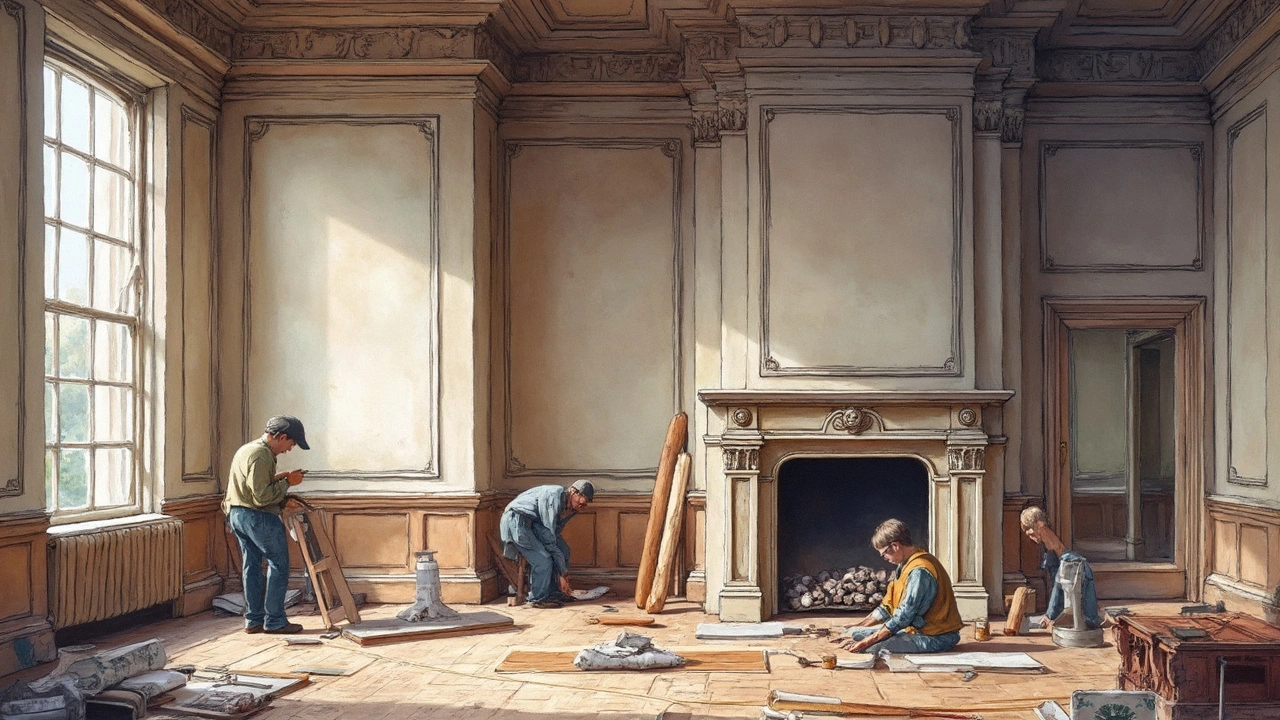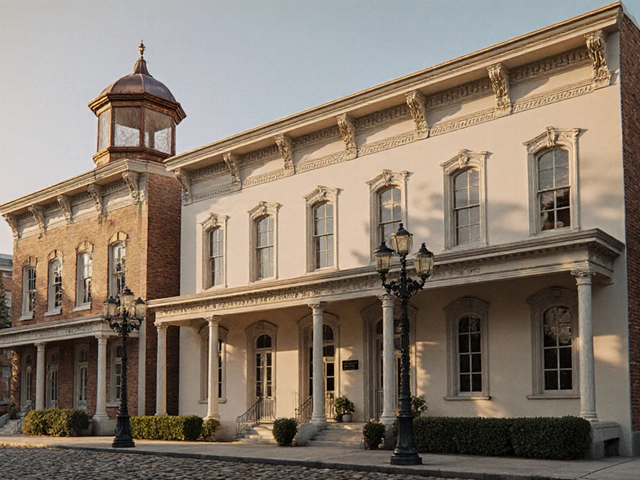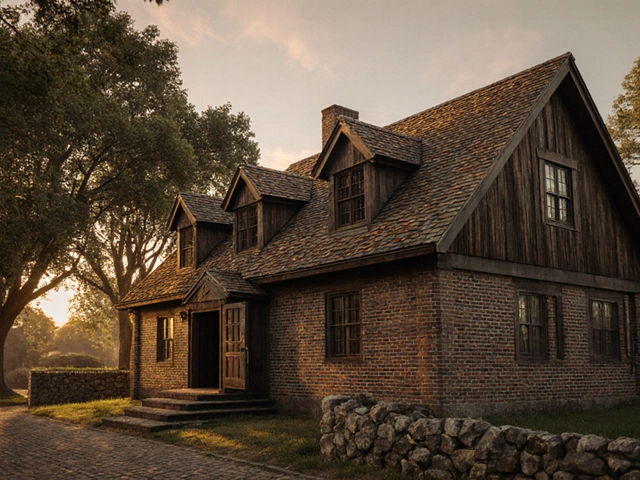You can spot a Greek Revival house from down the street: those tall columns, simple lines, and bold porches pretty much shout “old-school charm.” This style took off in the early 1800s, but the cool thing is, you’ll still see houses and even public buildings showing off these features today—sometimes right in the middle of a modern neighborhood.
Ever wondered why so many historic homes have that movie-set look with white pillars and fancy doorways? Greek Revival homes weren’t just about looking good. Back then, people saw them as patriotic, even a bit rebellious, since the style was tied to ideas of freedom and democracy. When I drive past one of these homes with Scarlett and Aiden, we all get the sense of history just hanging in the air.
If you’re in the market for a fixer-upper or just love wandering old neighborhoods, learning to spot the real Greek Revival elements—like those bold, flat moldings around doors or the unusual window setups—can be surprisingly useful. And if your own place has these features, simple fixes and some TLC can help keep that historic vibe alive without costing a fortune.
- What Defines Greek Revival Architecture?
- A Quick Stroll Through Its History
- Spotting Key Features in Real Life
- Why Preserving This Style Matters
- Tips for Caring for Greek Revival Homes
- Modern Twists on an Old Classic
What Defines Greek Revival Architecture?
Greek Revival isn’t just about sticking some columns on a house and calling it a day. This style grabs ideas straight from ancient Greek temples and brings them to regular neighborhoods. You’ll notice symmetry everywhere—if there’s a window or door on the left, there’s probably the same one on the right. Those big, bold columns out front? That’s a giveaway. And they don’t all have to be round—sometimes you’ll find square (they call them ‘Doric’) ones too.
The entry is almost always dramatic, with a wide, rectangular shape, sometimes topped with a “pediment”—that’s the triangle you see over the front part, sort of like a roof cap. Front doors often have small windows on the sides (called sidelights) and right above (a transom window), making everything look taller than it actually is. You might spot these touches not just on mega-mansions, but on regular houses and even tiny town halls across the U.S.
- Wide trim—called ‘entablatures’—runs along the roofline, making buildings look solid.
- Colors are usually simple—typically white or off-white, mimicking the marble of ancient Greece.
- Windows are often evenly spaced and typically have six panes over six panes (so, the classic 6-over-6 grid).
- No fancy stuff—decorations are bold but plain, no floral designs or busy patterns.
Here’s a quick cheat sheet to help you spot classic Greek Revival architecture:
| Feature | What to Look For |
|---|---|
| Columns | Tall, plain, often fluted, sometimes square |
| Pediment | Triangular gable above the entry or roofline |
| Sidelights/Transom | Narrow windows around the front door |
| Roof | Low-pitched or even flat |
| Color | Usually bright white |
One surprising fact? By the 1840s, about 25% of all new public buildings in the eastern U.S. were built in the Greek Revival style. This made it one of America’s first “go-to” looks, especially for banks, courthouses, and churches. If you’re poking around your city or town, those big white columns might be telling you a story about what folks wanted their places to say: strong, solid, and a little bit fancy, but still simple and approachable.
A Quick Stroll Through Its History
Greek Revival architecture took root in America fast—think about the 1820s up to the 1860s. All those columns and white paint weren’t just a trend; folks actually wanted their homes and courthouses to look like ancient Greek temples. Why? Because after the War of 1812, Americans were all about democracy, and ancient Greece pretty much wrote the original playbook.
What’s funny is Greek Revival didn’t even start here. It first popped up in Europe, with the Greeks fighting off the Ottoman Empire. Europeans got kind of obsessed with the old Greek look, and Americans followed, putting their own spin on it. By 1830, it was everywhere—east to west, city to farmland.
The style didn’t just stick with fancy city buildings. It showed up in small-town churches, farmhouses, and even schools. You can thank some creative architects, like Benjamin Latrobe and William Strickland, who made it a real movement. The U.S. Capitol even got a Greek Revival makeover after the British set it on fire in 1814.
| Decade | Key Events | Popular Areas |
|---|---|---|
| 1820s | Style gets going across East Coast cities | Philadelphia, Boston, New York |
| 1830s | Major public buildings and homes pop up | Georgia, the Midwest |
| 1840s-1860s | Farms, churches, and small towns jump in | Ohio, Illinois, Southern States |
So, why did Greek Revival fade out? Styles do that. After the Civil War, folks wanted something new, and Italianate houses started popping up instead. Still, driving through some towns today, you’ll see more than a few places that proudly keep those columns. It’s pretty wild to think about how much of our everyday landscape comes from such an old-school inspiration.
That vibe of democracy, hope, and clean lines in Greek Revival architecture hasn’t really lost its charm. It’s not just about looking classic—there’s a whole backstory in those walls and ceilings.
Spotting Key Features in Real Life
So, you’re standing in front of a house and wondering, “Is this the real deal?” Spotting Greek Revival architecture isn’t rocket science, but there are some details you don’t want to miss. These houses weren’t subtle. They wanted you to notice, and those design choices still jump out today if you know what to look for.
The easiest giveaway is those big, bold front columns. They usually look like something straight out of a Greek temple—tall, round, and set in a row, supporting the porch or entryway. Sometimes you’ll see square pillars, but more often, they’re round and chunky. These columns can be plain (Doric) or have decorative tops (Ionic or Corinthian), but even the simple ones make a statement.
Next, check out the roof. Greek Revival roofs are typically low-pitched or almost flat, and they usually have a front-facing gable that looks a lot like a triangle. Stand back and you might notice it feels like you’re looking at a slice of the Parthenon, just with modern shingles.
Doorways are another place where details matter. The main entrance will usually have a wide trim all around it, sometimes with little windows (called transoms and sidelights) letting in extra sunlight. The doors themselves tend to be heavy and tall, and you might even spot some tiny decorative brackets or moldings on the corners.
- Greek Revival architecture almost always goes for symmetry. That means windows and doors line up neatly, giving the house a real balanced, tidy look. Think of it like a kid lining up their building blocks, nothing too fussy or lopsided.
- Windows are often long and stretch all the way down toward the floor. Some homes even have six-over-six panes, which just means the upper and lower glass are divided into six squares each.
- You might also notice white paint everywhere (even if the house used to be another color). White was the go-to because it looked like the marble of ancient Greece, which people thought was super classy and important.
If you get a peek inside, look for wide, simple trim along the ceilings and windows, and maybe even some interior columns. These houses weren’t about fancy carvings or fussy details—they were more about making a big, bold impression with basic shapes and strong lines. Next time you’re on a walk or scrolling through old house listings, you’ll be able to spot a Greek Revival from a mile away.

Why Preserving This Style Matters
Saving Greek Revival architecture isn’t just about liking old buildings—it’s about hanging on to a true piece of American history. Homes, courthouses, and schools built in this style played a real part in how U.S. cities shaped their identities back in the early 1800s. A lot of these buildings popped up after the War of 1812, when folks wanted to show their pride and connection to the democratic ideas of ancient Greece. These aren’t cookie-cutter houses—they've seen centuries of family life, important decisions, and stories you’ll never find in a textbook.
When these structures are torn down or fall into disrepair, we lose more than white columns and wooden shutters; we lose craftsmanship that’s almost impossible to find today. Every detail, from handcrafted cornices to heavy front doors, reflects skills you just don’t see in modern construction—unless you’re willing to pay a fortune for custom work.
Keeping these homes in good shape also does wonders for neighborhoods. They boost curb appeal, draw in visitors, and even raise property values. Some towns, like Natchez, Mississippi and Hudson, New York, have built their identities—and tourism—around their rows of preserved Greek Revival houses. That means more local pride, more jobs, and a real sense of community.
If you own one of these homes, you’re not just fixing up a house. You’re protecting a piece of the country’s architectural DNA. And even small fixes, like repairing original woodwork or swapping modern materials for period-appropriate ones, can make a big difference.
Tips for Caring for Greek Revival Homes
Keeping a Greek Revival home looking sharp isn’t just about curb appeal—it’s about hanging onto pieces of history. These houses can be tough, but they need regular care, especially in places exposed to crazy weather.
Here’s what works best if you want your place (or any classic *Greek Revival architecture* you’re eyeing) to stay sturdy and true:
- Moisture is enemy number one. The wood trim, columns, and siding are magnet for water damage. Make a habit of checking for soft spots, flaking paint, and mildew every few months. Simple fixes like repainting and re-caulking seams keep water out and costs down.
- Focus on those iconic columns. Whether they’re wood, plaster, or even metal, columns need occasional inspection for cracks, rot, or rust. If you spot small problems, deal with them fast—patching holes or giving them a fresh coat of paint can save you from hefty repairs later.
- Watch the roof and gutters. Traditional Greek Revival roofs are pretty simple, but leaks or clogged gutters can lead to huge messes for ceilings, moldings, and cornices. Clear gutters every season and check if the flashing is tight.
- Mind the windows and doors. The signature tall, wide windows might have wavy old glass or unusual trim. Don’t rush to replace—repairing old wood frames and sealing air leaks keeps things authentic and surprisingly efficient.
- Stay true with paint colors. Classic Greek Revivals used white, cream, and pale gray, but sometimes you’ll see cool contrasts like black shutters or bold front doors. Stick to these combos when you touch up—that goes a long way toward holding on to the original vibe.
If you ever get stuck, it never hurts to go old-school: local hardware store pros and specialty restoration folks often know exactly how to handle quirky old house fixes. And when Scarlett and Aiden help me patch up our own porch posts, I always tell them—each repair is another way to keep the story of these homes going strong.
Modern Twists on an Old Classic
Greek Revival isn’t just something for museums or old movies. Plenty of today’s architects and homeowners want that classy look, but with things like open floor plans, smart tech, and energy-efficient updates. It’s not unusual to see a new build show off that big front porch and those classic columns out front, but the inside is all about function and comfort.
Here’s what’s popping up lately when folks give Greek Revival a modern upgrade:
- Greek Revival architecture with black-framed windows: Swapping old wooden sashes for sleek black frames is a big trend now. It gives a crisp outline, still works with the classic white exterior, and adds instant curb appeal.
- Mixing in sustainable stuff: Some builders use recycled wood for those signature columns, or they add modern insulation behind old walls. The look stays classic, but you get better energy savings.
- Open-concept interiors: People love big kitchens and living areas, so it’s common to knock down walls inside older homes while keeping the outside’s historic look—think roomy interiors hiding behind that 1800s façade.
- Smart home features: From hidden wiring for sound systems to apps that control the climate, it’s all about making historic spaces work for today’s lifestyles.
If you’re dreaming about mixing old and new, you don’t need a huge budget. Small stuff—like swapping in new, historically inspired lighting or freshening up trim with classic paint colors—makes a difference. And if you’re working with an architect, don’t be shy about showing them Instagram inspiration so you get that balance of timeless outside with “now” inside.
This approach lets you keep all the drama and history of Greek Revival but still live in a space that fits your actual life, not just the past. That way, you respect the style but you aren’t giving up on what makes home feel like home in 2025.





